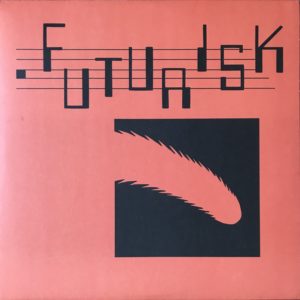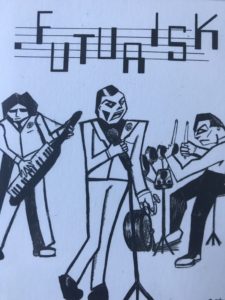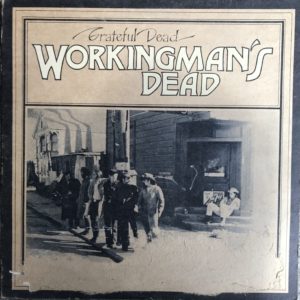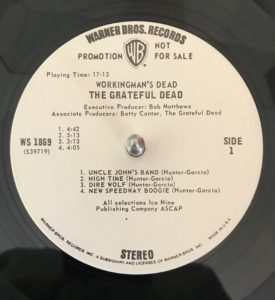I’ve typically been drawn to different bands for reasons that go beyond their music. A certain aesthetic will attract me to an artist, sometimes to the extent that the quality of the art is completely besides the point.
A few years ago I dropped in at Four Barrel Coffee in San Francisco where they play music on a turntable and have a selection of vinyl behind the counter. On this day they were playing a record that immediately caught my attention and I asked the barista what was spinning. “Futruisk!” he said as he pulled the jacket off the shelf and presented it to me.

I made a mental note and later started researching Futurisk records on the web. This was before I’d fully embraced vintage lp’s and typically sought want list items in new, reissued versions on Amazon or other marketplaces. I found such a reissue – a 2010 compilation of material from the band’s 1982 Piano Player EP, using the cover artwork from that title, and a single they put out in 1980 with my favorite track of theirs – “Army Now.”
It’s not high art, but the post punk, art rock, new wave, techno space rock amalgam that these Florida youngsters so enthusiastically wound together garnered enough interests for me to overlook the heavy handed themes and nerve severing sonics. More importantly, there was just something about Futurisk’s aesthetic that I really dug.

This record was in heavy rotation for a few weeks, much to the chagrin of my wife who managed to appreciate the band’s charms for all of about 20 minutes before she was forced to retreat into a state of resigned tolerance until my attention was drawn to other, preferably better musical discoveries.
Speaking of musical discoveries, a band that I’ve never been able to discover a fondness for, largely due to their aesthetic, is The Grateful Dead. Perhaps aesthetic is the wrong word, culture is really more accurate. The culture of The Dead has never been one that drew me in other than as a welcome source of drugs whenever the band played Berkeley during my stint at Cal in the late 80’s.
Yet despite that fact that I simply cannot suffer patchouli, Guatemalan fabrics, dread locks on white people or seriously kooky dancing I have tried to see the appeal of these guys periodically over the years, given the level of passion they’ve engendered with friends of mine and their immense fan base over the 50+ years The Dead has been recording and performing. But alas, it’s always been to no avail.
That is, until just yesterday…

 …I’d recently cleaned a copy of Workingman’s Dead I’d acquired from a friend of mine. She’d graciously given me her whole lp collection and there were quite a few gems in it. Other than the fact that this copy of W’s Dead is a white label promo, I wasn’t all that interested in it at first. If it were in better condition I’d likely have sold it, but something kept me from doing that and now it had made it’s way into the Walker Prelude re-cleaning rotation and I was going to give it a chance to win me over.
…I’d recently cleaned a copy of Workingman’s Dead I’d acquired from a friend of mine. She’d graciously given me her whole lp collection and there were quite a few gems in it. Other than the fact that this copy of W’s Dead is a white label promo, I wasn’t all that interested in it at first. If it were in better condition I’d likely have sold it, but something kept me from doing that and now it had made it’s way into the Walker Prelude re-cleaning rotation and I was going to give it a chance to win me over.
One of the pitfalls of placing such a high value on sonic quality is that I sometimes run the risk of placing sound quality over the quality of the music. Admittedly I’ve bought quite a few lp’s over the years because they were considered by some folks in the biz to be “audiophile records.” Improvements in my system and my critical listening skills have helped me realize that some of the records in my collection that I’d considered “audiophile records” simply are not. That is to say, they do not actually deliver an audiophile listening experience.
One such record is a copy of Jennifer Warnes’ Famous Blue Raincoat that I’d bought many years ago. For a long time I would use this record as one of my demo discs each time I made an upgrade to my system. It was the only time I would ever listen to the record, but I never thought to wonder why. One day I put this copy of FBR on the turntable and finally realized why I never played it – it didn’t sound very good. The music on my copy of the record, no matter how beautifully Jennifer sang Leonard Cohen’s wonderful songs, was not engaging for me because the shortcomings in playback were not allowing her work to be conveyed in a way that made me want to keep listening.
Realizing this was liberating for me. I enjoyed the music on FBR, but the record didn’t move me the way that my terrific copy of Pink Floyd’s Meddle or Bowie’s Ziggy Stardust did. I had to wonder why was I holding on to this copy of a record that was supposed to be an audiophile record but in the end, really wasn’t.
The holy grail for the audiophile record collector, in my view (if you identify here feel free to weigh in with a comment), is discovering a record that was not previously of interest, but because the quality of reproduction of the music on a particular copy is so high, it brings that artist’s work to life in a way that is so engaging it completely overwhelms and obliterates even the most entrenched opposition to the artist and/or their work. This experience is what makes all the time and expense of this hobby seem worthwhile to me.
Although to really face facts, the acquiring of ridiculously expensive stereo equipment in order to spend countless hours cleaning and playing records just to engage with reproduced music at ear shattering volumes is not the most socially responsible or personal growth oriented of hobbies. But as an audiophile we must push these sorts of thoughts quickly from our minds and get on with the business of upgrades and the seeking of religious listening experiences. What choice do we have?
When I was a younger and dumber budding audiophile it was all about paying lip service to good sounding music while trying to acquire cooler and more expensive gear than my friends and fellow gear heads. Now that I don’t know anyone who gives a rats ass about any of this stuff I’ve got no one to impress but myself. It makes the hobby a somewhat lonely one, but frankly I just can’t help myself anymore. I find discovering music this way to be so endlessly engaging that I don’t think I’ll be able to stop until l lose my hearing.
Getting back to The Dead, I finally did get around to cleaning this copy of Workingman’s Dead and while it’s not the best sounding record in my collection by any means, it does sound pretty good (at least the “B” side does). I played the record and gave side 2 a serious listen and… low and behold… the experience of being able to connect to Jerry and Bobby and company by way of a good pressing, rather well reproduced, made the experience of listening to the album and the band’s music more intimate and more engaging for me than at any time I’d every listened to The Dead in the past. By the time “Casey Jones” rolled to a close I found myself eager to flip the record over and play it all over again (to bad the “A” side doesn’t sound as good).
What ultimately impressed me about the record (if you’re a Dead Head reading this feel free to weigh in with a comment) is the sincerity of the performance on Workingman’s Dead. People always told me that you really need to see Then Dead live to fully appreciate them. While I realize that there’s no substitute for a live show, a great sounding record played on a good system has got to be the next best thing. In this case, hearing a good copy of WD was enough for me to overcome decades of resistance and change my mind about The Grateful Dead. I’m not sure I’d call myself a fan yet, but there are a lot fewer obstacles to that happening now.